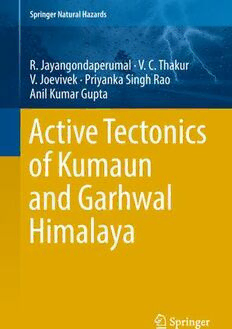
Active Tectonics of Kumaun and Garhwal Himalaya PDF
Preview Active Tectonics of Kumaun and Garhwal Himalaya
Springer Natural Hazards R. Jayangondaperumal · V. C. Thakur V. Joevivek · Priyanka Singh Rao Anil Kumar Gupta Active Tectonics of Kumaun and Garhwal Himalaya Springer Natural Hazards TheSpringerNaturalHazardsseriesseekstopublishabroadportfolioofscientific books, aiming at researchers, students, and everyone interested in Natural Hazard research. The series includes peer-reviewed monographs, edited volumes, text- books, and conference proceedings. It covers all categories of hazards such as atmospheric/climatological/oceanographic hazards, storms, tsunamis, floods, ava- lanches,landslides,erosion,earthquakes,volcanoes,andwelcomesbookproposals on topics like risk assessment, risk management, and mitigation of hazards, and related subjects. More information about this series at http://www.springer.com/series/10179 R. Jayangondaperumal V. C. Thakur (cid:129) V. Joevivek Priyanka Singh Rao (cid:129) Anil Kumar Gupta Active Tectonics of Kumaun and Garhwal Himalaya 123 R. Jayangondaperumal PriyankaSinghRao Structure andTectonic Group Structure andTectonic Group WadiaInstitute ofHimalayan Geology WadiaInstitute ofHimalayan Geology Dehradun, Uttarakhand Dehradun, Uttarakhand India India V.C. Thakur and Structure andTectonic Group WadiaInstitute ofHimalayan Geology Geological Surveyof India Dehradun, Uttarakhand Government of India India Hyderabad, Telangana India V.Joevivek Structure andTectonic Group Anil Kumar Gupta WadiaInstitute ofHimalayan Geology Structure andTectonic Group Dehradun, Uttarakhand WadiaInstitute ofHimalayan Geology India Dehradun, Uttarakhand India and and Akshaya Collegeof Engineering and Technology Department ofGeology andGeophysics Kinathukadavu, Coimbatore,Tamil Nadu Indian Institute of Technology Kharagpur India Kharagpur, West Bengal India ISSN 2365-0656 ISSN 2365-0664 (electronic) SpringerNatural Hazards ISBN978-981-10-8242-9 ISBN978-981-10-8243-6 (eBook) https://doi.org/10.1007/978-981-10-8243-6 LibraryofCongressControlNumber:2018931503 ©SpringerNatureSingaporePteLtd.2018 Thisworkissubjecttocopyright.AllrightsarereservedbythePublisher,whetherthewholeorpart of the material is concerned, specifically the rights of translation, reprinting, reuse of illustrations, recitation, broadcasting, reproduction on microfilms or in any other physical way, and transmission orinformationstorageandretrieval,electronicadaptation,computersoftware,orbysimilarordissimilar methodologynowknownorhereafterdeveloped. The use of general descriptive names, registered names, trademarks, service marks, etc. in this publicationdoesnotimply,evenintheabsenceofaspecificstatement,thatsuchnamesareexemptfrom therelevantprotectivelawsandregulationsandthereforefreeforgeneraluse. The publisher, the authors and the editors are safe to assume that the advice and information in this book are believed to be true and accurate at the date of publication. Neither the publisher nor the authorsortheeditorsgiveawarranty,expressorimplied,withrespecttothematerialcontainedhereinor for any errors or omissions that may have been made. The publisher remains neutral with regard to jurisdictionalclaimsinpublishedmapsandinstitutionalaffiliations. Printedonacid-freepaper ThisSpringerimprintispublishedbytheregisteredcompanySpringerNature SingaporePteLtd.partofSpringerNature Theregisteredcompanyaddressis:152BeachRoad,#21-01/04GatewayEast, Singapore189721,Singapore Dedicated to all those working on active fault of the Himalaya Preface InHimalaya,aboutonehundredthousandliveshavebeenlostinlargeearthquakes duringthepastonehundredyears.Thelossoflivesandpropertycanbeminimized through intervention of improved construction technology and incorporating buildingcode.TheHimalayanregionisundergoingfasteconomicdevelopmenton a large scale in the areas of hydroelectric power generation, building of highways including tunnels, tourism infrastructure, and other societal projects. In the frontal Sub-Himalaya and adjoining Ganga plain, there is ongoing development of industrial units and transport sector. It is in these types of infrastructure creation projectsthattheactivefaultstudies(includemappingandcharacterizationofafault scarp using paleoseismological investigation) assume importance. A fault scarp is definedasatectoniclandformcorrespondingto,orroughlycoincident,afaultplane thathasdisplacedthegroundsurface.Geneticrelationshipbetweentheactivefaults and earthquakes has now been established in the case of some of the destructive earthquakes, like 1994 Northridge, 1999 Chi-Chi, and 2005 Kashmir earthquakes. This has given rise to recognition of the hazard posed by active faults to the infrastructureandsociety.Thereareexamplesofnear-totalannihilationofavillage, severe damage to educational infrastructure killing children and destruction of a large bridge over a river located close to the active faults in areas moderately damaged by earthquakes. In Himalaya, the major projects have been built taking into consideration the peak ground acceleration parameter. In the absence of an active fault in the project area, this may hold good and may be applicable for assessing vulnerability and safety of the infrastructure, whereas in the presence of an active fault in the vicinity of an infrastructure project, there will be an expo- nential increase in the risk factor. It is therefore imperative that the engineers also consider the occurrence or presence of an active fault and its characteristics in selectingthelocationanddesigningtheinfrastructureproject.Theactivefaultstudy has developed into an important area of research in earthquake hazard assessment, involving mapping, tectonic geomorphology, paleoseismology, and geochrono- logical dating. The multidisciplinary approach is applied to determine the active fault properties that include the timing and magnitude of slip and vertical offset. There is now global recognition, and there are ongoing international programs on vii viii Preface active faults. Kumaun and Garhwal are the two regions of Uttarakhand State. The state suffered loss of lives and property during the moderate 1991 Uttarkashi and 1999 Chamoli earthquakes. In the historical past, there was a major devastating earthquakeofAD1803inGarhwal.Thereisalsopaleoseismicevidencethatagreat paleoearthquake in AD 1344 ruptured the Himalayan front and reactivated the Himalayan frontal fault. The large earthquakes originate in the Lesser Himalayan hinterland and the ruptures propagate to the forel and breaking the ground surface or remain blind at depths like the 2015 Gorkha earthquake in Nepal. The Sub-HimalayazonebetweentheMainBoundaryThrustandtheHimalayanFrontal Thrustischaracterizedbyactivefaults.Inthisbook,wehavefocusedourstudyon the active faults of this zone in Uttarakhand. Dehradun, India R. Jayangondaperumal July 2017 V. C. Thakur V. Joevivek Priyanka Singh Rao Anil Kumar Gupta Acknowledgements Throughout the process of writing this book, many individuals from the Earth ScienceCommunityhavetakentimeouttohelpusinthisendeavor.Weappreciate the community as a whole for actively participating in the feedback and contri- butions for this book. We express our gratitude to the Director, Wadia Institute of HimalayanGeology(WIHG),Dehradun,forpartialfinancialsupportandproviding the infrastructure and laboratory facilities through institutional flagship project to carryoutthiswork.WewouldliketothanktheManagementofAkshayaCollegeof Engineering and Technology, Coimbatore, for providing the infrastructure support to complete this task. We appreciate Mr. Rajeeb Lochan Mishra for helping us in the process of editing the document. The authors thank Prof. Robert S. Yeats and the anonymous reviewers for their useful comments in improving the book chap- ters.Thankstopublisherforacceptingourproposalandpublishingthebookunder Springer Natural Hazards book series. We would extend our gratitude to the edi- torialmembersfortheirassistanceinediting,proofreading,anddesignofthebook. Above all, we would like to thank our family members for their support. ix About the Book Thebookcontributes tounderstandingthepattern ofstrainreleaseandthelevelof seismichazardimposedbylarge-greatearthquakesinthefrontalfold-thrustbeltsof Kumaun and Garhwal regions of Uttarakhand. The motivation for active fault studies and their characterization have been emphasized. The book presents the compilation of knowledge garnered in multidisciplinary or proxy studies involved intheunderstandingofseismichazardingeneralandKumaun–GarhwalHimalaya regions in particular with lucid new maps draped on modern Cartosat or SRTM DEM data. It also discusses satellite image calibration, active faults iden- tifications, and map productions with flowchart. The book discusses window-wise active fault elements with attributes together with the tectonic geomorphic map. It also includes active fault scarp with topographic profile along with field pho- tographs.Finally,itreviewsallexistingseismotectonicmodelsoftheHimalaya,its earthquake hazard, and its vulnerability, specifically for Kumaun and Garhwal regions. xi
